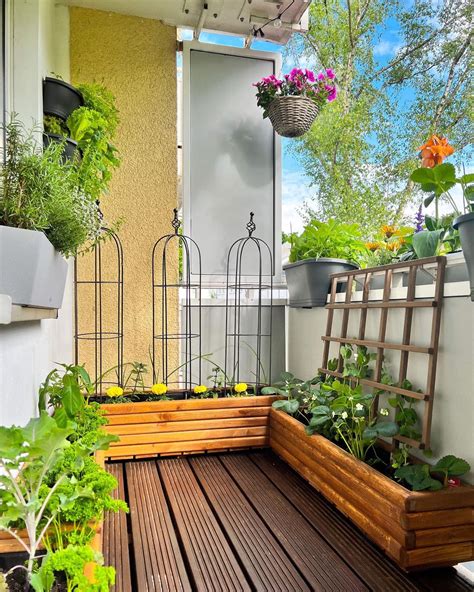How to Create a Space-Saving Vertical Garden on Your Balcony
Vertical gardening is an increasingly popular way to maximize small outdoor spaces, especially in urban areas where balconies are the primary option for home gardening. In this article, we’ll dive into everything you need to know about creating your own vertical garden on a balcony. This guide will provide practical steps for designing, planting, and maintaining your garden to create a lush, space-efficient green wall or garden that enhances both your living space and the environment.
Introduction
Whether you’re an experienced gardener or a beginner looking for fresh balcony ideas, a vertical garden offers a creative solution to limited space. It allows you to grow a variety of plants, including flowers, herbs, and even vegetables, without taking up valuable floor space. By utilizing walls and vertical planters, you can transform your balcony into an urban oasis that’s both functional and beautiful.
Key Concepts
- Vertical Gardening: A method of growing plants upwards using supports, containers, and planters, which helps in maximizing small spaces like balconies.
- Space-Saving: The main goal of a vertical garden is to conserve ground space, allowing for a larger variety of plants in small areas.
- Plant Arrangement: Strategically placing plants to optimize sunlight, air circulation, and aesthetic appeal.
- Wall Planters: Containers or structures mounted on walls to grow plants vertically.
- Climbing Plants: Species like ivy or jasmine that naturally grow upwards and are ideal for vertical setups.
Historical Context
While modern urban gardening has brought vertical gardens into the mainstream, this concept dates back to ancient civilizations. The Hanging Gardens of Babylon are one of the earliest known examples, showcasing the historical appeal of maximizing space while adding aesthetic beauty. Over time, vertical gardens evolved to suit contemporary needs, particularly in densely populated cities with limited outdoor space.
Current State Analysis
Today, vertical gardens are a staple of urban gardening, especially in cities where outdoor design must take into account limited space and environmental factors. The demand for green spaces in concrete jungles has led to innovative products such as modular wall planters, self-watering systems, and lightweight plant supports. As more people look for ways to lead sustainable lifestyles, vertical gardens have become an eco-friendly solution that benefits both the environment and personal well-being.
Practical Applications
Building a vertical garden on your balcony is a straightforward process, but it does require careful planning. Below are some key steps:
- Assess Space and Sunlight: Measure your balcony to determine the space available for planters, and note how much sunlight the area receives daily. Different plants require varying levels of light.
- Choose Your Planters: Wall-mounted planters, hanging baskets, and tiered shelves are popular options. Consider self-watering planters if you live in a dry or hot climate.
- Select Plants: Choose plants based on the light and climate of your balcony. Herbs, succulents, and climbing plants like peas and beans are ideal for beginners.
- Arrange Plants Strategically: Place taller plants like tomatoes and climbing plants at the back or along the walls, while shorter plants and herbs can be placed at lower levels.
- Ensure Proper Drainage: Good drainage is essential to avoid root rot. Make sure your planters have adequate holes and consider using a tray or liner to catch excess water.
Case Studies
| Balcony Size | Plant Types | Challenges | Solutions |
|---|---|---|---|
| Small (5×5 ft) | Herbs, Succulents | Limited sunlight | Use reflective surfaces to bounce light |
| Medium (8×8 ft) | Climbing Plants, Flowers | Overcrowding | Tiered planters to optimize vertical space |
| Large (10×10 ft) | Vegetables, Perennials | Heavy winds | Use windbreakers or plant wind-resistant species |
Stakeholder Analysis
- Balcony Owners: Vertical gardens offer them a space-saving, aesthetically pleasing way to engage in gardening.
- Plant Enthusiasts: They benefit from expanding their plant collection in limited spaces.
- Urban Planners: Vertical gardens contribute to urban greening initiatives, improving air quality and reducing urban heat islands.
- Landlords: Encouraging vertical gardening can enhance property values and attract eco-conscious tenants.
Implementation Guidelines
- Start with a Plan: Draw a layout of where planters will be placed and what types of plants will go in each location.
- Prepare the Balcony Surface: Make sure walls can support mounted planters, and that the balcony structure can handle the additional weight.
- Install Planters: Begin with larger fixtures, like wall planters or shelves, and work down to smaller containers.
- Watering System: If possible, install a drip irrigation system to reduce maintenance and ensure consistent watering.
- Monitor Plant Growth: Regularly check your plants for signs of overgrowth, pests, or nutrient deficiencies.
Ethical Considerations
While vertical gardens are an eco-friendly solution, there are ethical considerations to keep in mind:
- Water Usage: While vertical gardens often use less water, it’s essential to be mindful of water conservation practices, particularly in drought-prone areas.
- Material Sourcing: Choose eco-friendly materials for planters, avoiding plastics where possible and opting for recycled or biodegradable options.
Limitations and Future Research
Despite their benefits, vertical gardens have some limitations. They may not be suitable for all plants, especially those with extensive root systems. Additionally, managing water and sunlight can be more challenging in vertical arrangements than in traditional gardens.
Future research could explore advances in automated irrigation systems for vertical gardens, more resilient plant varieties suitable for limited soil depth, and eco-friendly materials that offer both durability and sustainability.
Expert Commentary
Experts in urban gardening often highlight the potential of vertical gardens to transform cityscapes. With growing concerns about climate change and food security, balcony-based vertical gardens could play a pivotal role in creating sustainable living environments. By incorporating green walls into urban design, we not only make better use of space but also improve air quality, reduce noise pollution, and foster mental well-being.


